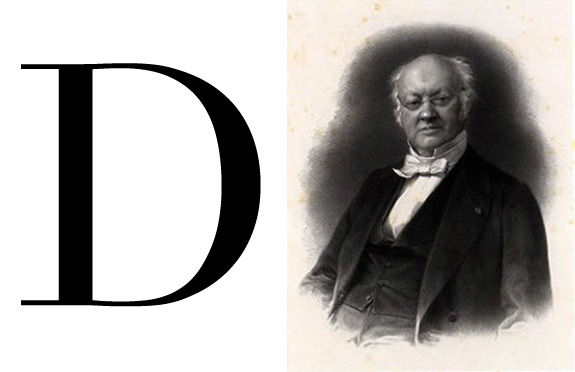January 7

Born into the family of a French printer on this day in 1730 was François Ambroise Didot, who was destined to become the most influential member of one of the most distinguished families ever to practice the printer’s craft. Along with his younger brother, Pierre François, F.A. Didot fully established the family reputation in the areas of printing, typefounding, publishing, and bookselling.
As a typefounder, François Ambroise made two outstanding contributions, the effects of both of which have lasted for almost two hundred years. In the mid-18th century French typography, the types of Pierre Fournier—patterned upon the roman du roi which Grandjean had cut for Louis XIV in 1699—were widely admired. It was Didot who continues the development of this letter, which was so far removed from the earlier oldstyles. He increased the contrast between the heavy and light strokes and created serifs which were hairline and without brackets. The capitals of this design were considerably more condensed than the Italian styles of Aldus which had earlier been so influential in the development of the French types of Garamond.
This new letter, cut at Didot’s direction about 1780 by the punchcutter Waflard, was no doubt also influenced by the types of the Englishman, John Baskerville. In turn, the Didot letter, which became the embodiment of the type classification now called modern, encouraged the Italian printer, Giambattista Bodoni, to rid himself of an earlier dependence upon the Fournier types. The new design of Didot was further developed by his successors in the family and dominated European typography for another sixty years. The Didot style prompted French printers to discard almost completely the oldstyle faces.
Didot’s next great contribution was concerned with the mechannics of typefounding. As early as 1737 Fournier had introduced a method of type measurement in which he divided an inch into seventy-two divisions called points. The twenty types sizes established by Fournier were all given the names already applied to type sizes, but the fixed relationship between sizes, established by a standard, was the first important move in the direction of precise measurement in typecasting.
Didot improved upon the Fournier method by using as a standard the French pied du roi which contained 12 inches, equivalent to 12.7892 American inches. He further adhered strictly to type sizes described in points rather than in the indiscriminate names heretofore used. While there was opposition to such a system the wide reputation of the Didot family led to the general acceptance of the idea. As a result, the present European standard of measurement for type sizes remains that devised by Didot, and names are no longer assigned to sizes, although it took another century to accomplish this innovation.